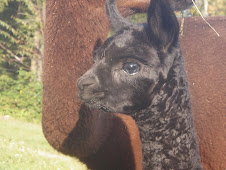Monday, July 30, 2012
To Do the IgG Test or Not?
I no longer do a routine IgG test after the birth of an alpaca cria. Here is some information about the test and why I don't do it anymore:
The IgG Test
measures the Immunoglobulin G transferred from the mother to the cria thru the
colostrum. It is the most abundant of the different types of antibody and is
found in all body fluids and protects against bacterial and viral infections.
The antibody produced by the mother and passed to the cria against a specific
antigen, provides the cria with some protection should that antigen enter their
body within the first three weeks (after which the transferred IgG is not
longer present). From birth the cria also begins to develop their own IgG
response. The cria's immune system "remembers" its response to an
antigen and has a better chance of fighting it.
Why don't I do
the test anymore? I used to do it and all my crias tested had outstanding, high
IgG levels. Then I had one that had a reading that was on the low side of
acceptable. I was given the option of doing a plasma transfer or watching the
cria. Since the plasma would take a few days to get I decided to watch. The
cria was vigorous and never had an issue. Then a year later I had one that had
an incredibly high IgG and she crashed on day two. She was is really bad shape,
near death. The vet gave her a plasma transfusion and it did nothing to help
her, she continued to decline. A very experienced alpaca breeder told me the
best I could do for her would be to get an IV inserted and also treat with
antibiotics. She had a shunt put into her neck and I gave her IV fluids around
the clock for 3 days. She responded almost immediately to this treatment.
So as a
livestock breeder one has to decide which tests and treatments are really
necessary and will be a worthwhile expense against the sale of that animal.
Paying for a vet visit, blood withdrawal and test is expensive and to my small
operation, not a worthwhile expense. If a cria is going to crash, I am going to
see it and treat that cria with excellent care to get it through the challenge.
Knowing the IgG only lets you know that "maybe" if the cria
encounters a challenge, "maybe" the cria will be able to fight it on
its own. Or in the case where the cria has a lower IgG that that cria
"maybe" will have a problem. So that is not really useful information
to me. Knowing what IgG was transferred from my dam to her cria would have
done me/her no good. She did not have any infection at birth but was slow to
get up and nurse. Once she did (24hours) she was fine on her own indicating
that she was not experiencing an antigen challenge. By the time she had her
next episode (around 2 months) she was of an age where she would no longer have
protection from mother's transfer and should have developed her own IgG.
Subscribe to:
Post Comments (Atom)









No comments:
Post a Comment